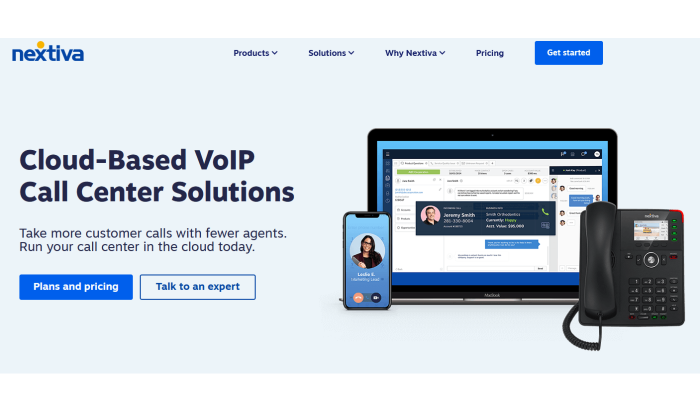
Disclosure: This content is reader-supported, which means if you click on some of our links that we may earn a commission.
Want to jump right to the point? My top pick for the best call center software is Nextiva.
Nothing scares customers away like hard-to-reach customer service or disorganized sales calls.
Using the best call center software can outfit your teams with the tools they need to communicate more effectively.
Forget about the requirements of physical office space or a landline. Modern call center software is all you need to get employees set up, no matter where they are working.
You still have the hard work of engaging your customers and clients, but all the heavy lifting associated with maintaining a call center is off your plate.
Read on for in-depth reviews of my top picks. I’ll explain what they offer and the types of businesses they work well for.
After the reviews, I’ve included a brief guide to help you evaluate the leading options and find the one that’s best for you.
#1 – Nextiva — The Best Way to Take Your Call Center Virtual

We’re quickly leaving the days where call centers only exist in a phone bank in your building. VoIP has made communication from anywhere possible and Nextiva’s platform delivers a full solution for taking your call center and overall communications virtual.
It’s all built on Nextiva One, their all-encompassing VoIP solution that covers voice, video, text, fax, and team chat.
Some call centers can likely get away with the lowest-priced Nextiva One plan—Essential—because it comes with unlimited voice and video calling, an auto attendant, Outlook and Google Contacts integration, and local and toll-free numbers. For most teams, that just runs you about $20 per user per month (pricing scales up for fewer users and vice versa).
However, for useful extras like CRM integration, call pop, texting, and conferencing, I suggest the Professional plan, which is just $4 more per user per month than Essential.
Nextiva One is super easy to get set up since it’s completely VoIP-centered and cloud-based. And, you can get that and Nextiva’s call center software implemented in one fell swoop.
Nextiva call center software comes as an add-on of either $50 or $100 per user per month on top of your Nextiva One bill.
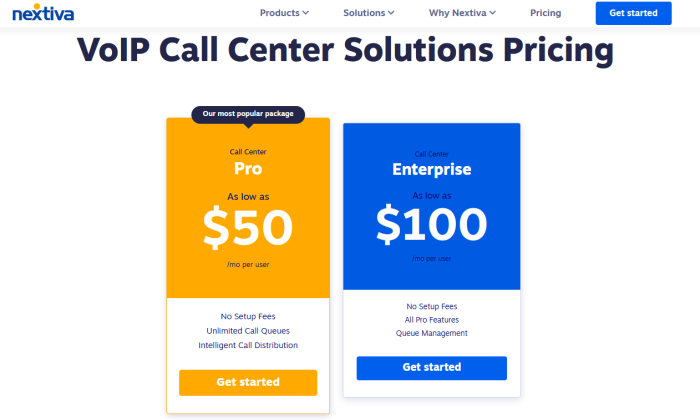
With both options, you get call recording, customizable reporting, automated call distribution, IVR for your auto attendant, and unlimited call queues.
The $100 Enterprise option unlocks more supervisor tools, like finer call routing management, call tagging, silent monitoring for supervisors to listen in on calls, and whispering to reps during pre-call.
What’s great is if you have an existing call center or need to spin one up, Nextiva makes it lightning fast to set up your cloud-based call center.
And since Nextiva can work on computers with its desktop app, mobile devices with its mobile app, and desk phones, you can have your virtual call center reps conduct their work from anywhere. Have a hybrid remote and on-premises call center, staff yours entirely with remote workers, or keep it truly in-house—any way you want it, Nextiva makes it work, and easily.
Get started with Nextiva to build your call center solution and make it futureproof with the power of VoIP.
#2 – Aircall — The Lowest Price on Complete Call Center Software
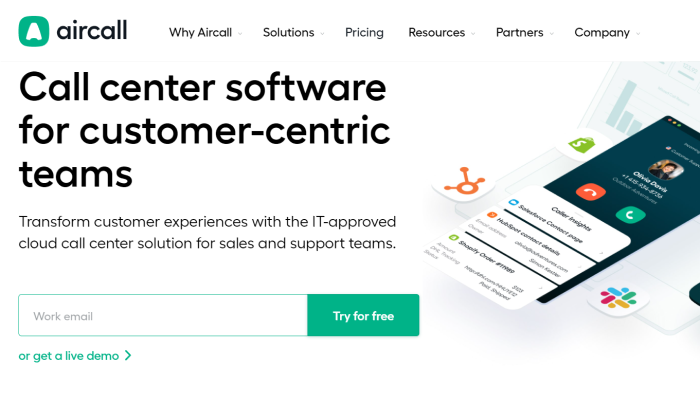
For less than half the cost of other good call center software, you can outfit your agents with Aircall.
Aircall is sleek and integrates with popular business apps. The interface feels lightweight and it’s super easy to navigate, even for first-timers.
You might think a low price would mean that you don’t get as many helpful features. That’s not really true.
Transfer calls to another agent. Make it a warm transfer and let the new agent know what’s happening before passing the customer over. View a customer’s record before you pick up the call without having to sign into your CRM. It’s all right there.

You’ll get real-time metrics, clear reports, and the ability to route incoming calls much the same as you get with the heavy-weight platforms.
Set up an IVR to allow customers to find their way to the right department, manage call queues, and allow callers to get a call back later if the wait time is high.
Some of the other features include:
- Skills-based routing
- Call tagging
- Ring groups
- Shared contacts
- Call conferencing
- Power dialer
Simply highlight a list of contacts or select a list. The powerful auto dialer gets to work saving clicks and time for every conversation.
So why is Aircall so much less expensive? The main reason is that it’s not omnichannel out of the box. Yes, you can set up SMS messaging via the integration with Salesmsg, but that’s going to cost extra. The other more expensive products I reviewed offer all the channels in-house.
In a way, that’s the beauty of Aircall. It’s a simple yet powerful solution. It’s like the missing puzzle piece that connects voice communications with the rest of your business.
Developers can use web hooks and APIs to extend Aircall’s connectivity with other software. Everyone else can use the one-click integrations with 85 apps like Salesfoce, HubSpot, Microsoft Dynamics, Zendesk, Slack, Shopify, Big Commerce, Intercom, and the list keeps growing.
If you are already using these apps, Aircall may be a great way to get the call center you need without breaking the bank.
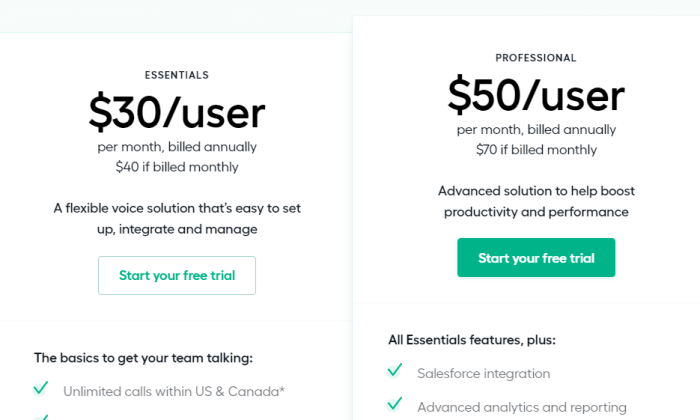
With the Essentials plan, which starts at $30 per user per month, you’re getting a complete call center for voice. This includes unlimited calling in North America. Remember that some vendors charge per minute for calls, so this can amount to a really big savings.
With the Professional plan, which starts at $50 per user per month, there are additional analytics and coaching features, as well as increased customer support.
For large call centers, this is a good idea, as you will have a dedicated account manager and one-on-one onboarding to get everything hooked together right the first time.
One important thing to note is that Salesforce integration comes with Professional only. However, Essentials supports every other integration.I can’t overstate the ease of use for Aircall. You should really schedule a demo if you are interested in an affordable solution to empower your agents. Or just start a 7-day free trial today.
#3 – Dialpad — The Safe Way to Migrate a Traditional Call Center to the Cloud
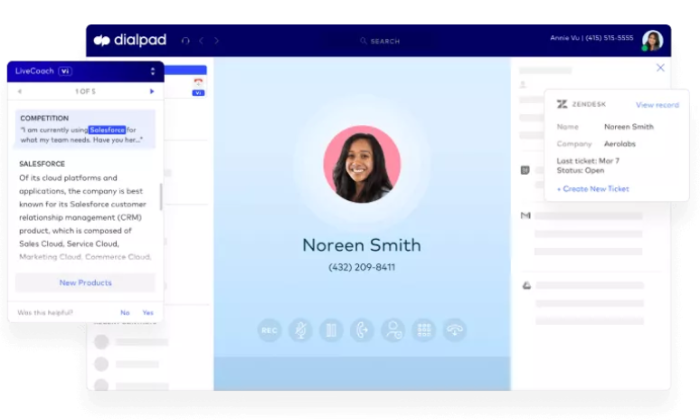
Dialpad is a phenomenal cloud-based call center that ties into traditional landline infrastructure. You can go total cloud day one, if you want, or stay hybrid and modernize at your own pace.
This allows companies to maintain their investment in hardware, while immediately taking advantage of the cloud-based platform. Unify your business phone system with text, chat, fax, and web conferencing. Allow your employees to work from the office as easily as from home.
Migrating your phone system to the cloud is stressful. Lots of vendors promise a turnkey solution, but anyone who has ever handled a large scale business communications transition knows it’s rarely that simple.
Dialpad offers two on-premise gateway options to connect your traditional phones to its cloud platform. Whether you rely on a traditional PBX or the PTSN, you can continue to use existing systems seamlessly.
The company offers continued support for desk phones, conference phones, and allows you to port numbers without a break in service. International numbers are available as well.
Instead of having to make a giant transition immediately, companies can phase out embedded technology at their own pace.
The best part is that the benefits are immediate. You get deep calling and routing features that are so much easier to manage than a traditional PBX. Plus, all of your channels are in a single interface for administrators and agents.
Some of the other highlights of the platform include:
- Call routing and queues
- Virtual hold
- Real-time and historic reports
- Call monitoring and coaching features
- Data backup
- Voice intelligence
The voice intelligence features of Dialpad are particularly well developed. It transcribes conversations, making it easier to search through later. Post-call summaries are generated automatically, complete with action items and a recorded meeting sentiment.
It can also assist agents by picking up on conversations and automatically providing relevant documentation.
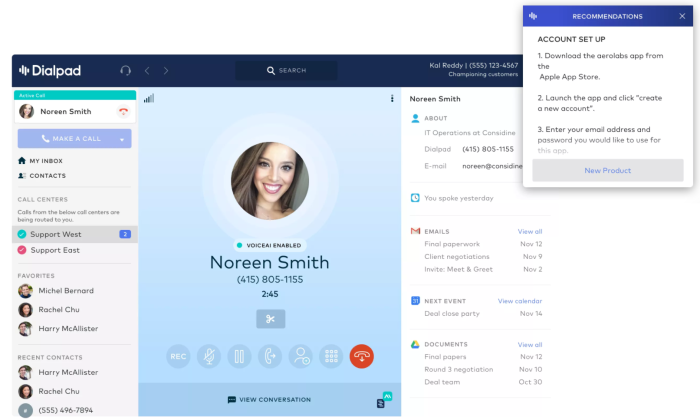
Your old phone line won’t do that on its own. But with Dialpad’s help, you can continue to use phones alongside VoIP, chat, and text. Regardless of how customers reach out, agents will interact through the centralized cloud platform.
Dialpad Pro starts at $125. This is typical for high-quality call center software, but one thing to like about Dialpad is that all the integrations come with Pro. This includes Salesforce, Zendesk, Slack, among others.
You also get unlimited calling in whatever country your account is based unlimited SMS, and MMS in North America. They also provide 24/7 phone support for all Contact Center plans.
If you are just looking for a sales call center solution, you might want to check out Dialpad Sell. You’ll get a lot of the same features that help teams stay organized, as well as a powerful outbound dialer.
No matter how you want to use it, though, Dialpad is definitely a good option for the modern call center. It may be the best if you are trying to make use of your business phone system, or want to move to the cloud gradually.
For a pain-free migration, get in touch with Dialpad today.
#4 – Five9 — Best for Reaching More Customers Without Adding Reps
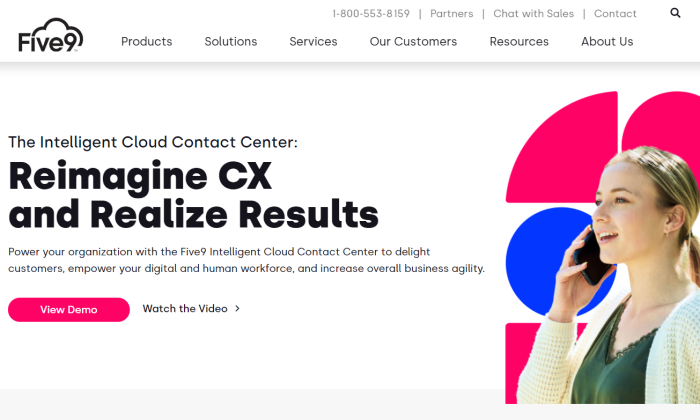
Five9 centralizes every channel you use within a single clean interface for your employees. It works for any call center application–Five9 is one of the leading providers in the space–but I think it stands out for sales teams.
Discover and connect with leads on social media. Call someone who just filled out a form on your landing page. Answer text inquiries with an email follow up.
No matter how your customers show interest, your reps can talk with them from a single platform. Whether you’re building relationships over a long sales cycle or telemarketing directly to consumers, Five9 gives your reps the tools they need.
You get an auto dialer with multiple modes for prospecting and working through call lists. It comes with built-in calls to manage Do Not Call Lists and maintain TCPA compliance, which lowers your risk of running into issues with outreach at scale.
The same rep who was making 10 calls an hour now makes 50 without breaking a sweat. Everything is tracked in a few clicks within the system, and they are on to the next lead.
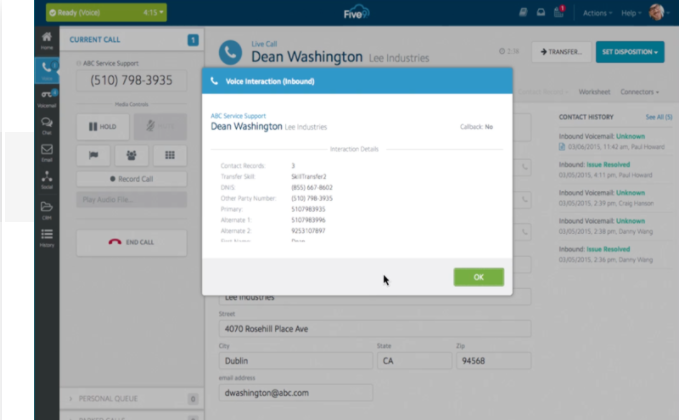
Five9 has sales features like web callbacks that you certainly don’t expect from call center software. Say someone enters their contact information on your website to access content about your product. Five9 can get that contact information to the front of your call queue, ensuring a conversation with a lead who’s actively interested.
Strike while they care. Watch conversation rates climb instead of speaking to cold leads weeks later.
You can take advantage of skills-based routing, regardless of how customers are reaching out. Ensure that account executives are the first person to pick up when big clients call in. If they’re in a meeting, route the call to the next best person who understands this client’s needs.
Managers will have complete visibility into their team. It doesn’t matter if people are working from home or on-the-go.
And supervisors aren’t the only ones with a bird’s eye view. Role-based dashboards let agents track their progress, as well. Executives get detailed information about how to steer the ship.
Everyone knows what’s going on in their lane. There’s no surprises about hitting goals.
Like I said, Five9 is one of the major players in the communications space. You’ll have access to pretty much any call center feature there is. Some of the ones that best serve sales teams include:
- Skill-based scheduling and forecasts
- Agent scripting
- Drag-and-drop IVR
- Customizable KPIs
- Gamification and virtual rewards
- Integration with Microsoft, Oracle, Salesforce, and others
To get a price on Five9, you’ll have to reach out. I suspect it’s somewhere north of $100 per user per month, given what other omnichannel solutions cost. There are four different plans to choose from, so you don’t have to pay for features you’re not going to use.
Five9 doesn’t have a laundry list of integrations like some of the other tools I looked at, but
Here, I want to step back for a second. I’m really highlighting the sales features because I think Five9 offers the most complete package in that regard.
But you can run an amazing customer service call center with it. For sure. Universities and hospitals would be happy to use Five9 to centralize communications, especially if they are using some clunky system that looks nothing like the other tools they’re using.
Make it easier for every rep to reach more people. Make every conversation just a little bit better by giving agents the tools they need to connect on any channel. Get in touch with Five9 today to request pricing.
#5 – 8×8 Contact Center — Best for Large Customer Service Call Centers
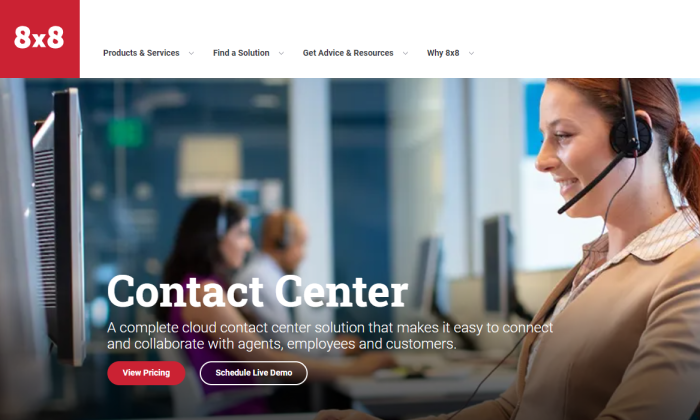
8×8 Contact Center is one of the more robust tools on the market. 8×8 has been around for a long time and can fully support migration to a UCaaS contact center.
You can set it up for any size or purpose, but I recommend it highly for large customer service call centers. Why? Because working in these environments is stressful. There’s high turnover, as new agents struggle to deal with irate customers and veteran supervisors burnout.
8×8 gives you a complete set of tools to fully support agents and help supervisors keep morale high. You’ll be able to retain talent by making the day-to-day a little bit less hectic, and happier agents lead to happier customers.
Imagine day one for a new hire at a call center. If they’re working on 8×8, they’ll have everything they need as soon as they put on a headset. This includes easy access to a deep knowledge base of call scripts, best practices, and a library of recorded calls that showcase agents at their best.
The speech analytics tools are really helpful as well. You can use them to ensure that new hires are sticking to the script, and they will be able to read voicemails instead of having to listen to them. This makes it easier for agents to scan through the backlog for important calls.
Supervisors can use the speech analytics to discover trends in customer inquiries and potential gaps in efficiency that would be impossible to bring to the surface otherwise. They’ll also have a dashboard that reports important metrics clearly, making it easy to recognize when agents require more support.
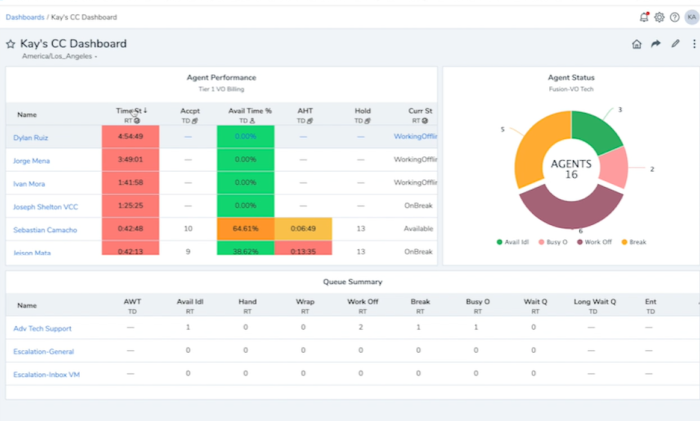
8×8 also offers an intelligent IVR that gives your customers self-service options. This lowers operational costs, as agents no longer have to speak with customers for simple requests. This cuts down your time to resolution, and keeps agents energized because they’re not handling the same call over and over again.
The ACD is capable of handling skills-based routing, so you can ensure that calls are getting to the right agents. This is important if you offer service in multiple languages, or have agents divided by departments based on expertise.
Intelligent routing is especially important for organizations that offer premium service packages to particular clients. These customers don’t want to get an entry-level agent who doesn’t understand the ins and outs of their system.
Both the ACD and IVR are easy enough to configure that you won’t have to worry about calling IT or 8×8 to build a solution that works. Simply use a visual drag-and-drop builder to customize.
8×8 Contact Center is highly extensible. There are integrations with tons of the top products you already use, and API’s that let developers add even more functionality. Additional features include:
- Social media, chat, email, and SMS
- Customer surveys and quality management
- Call and screen recording
- Payment processing
- Virtual agent
- Workforce management tools
Pricing for 8×8 Contact Center comes in a few different forms.
You can get it as a part of 8×8’s all-in-one communications platform, known as the X Series. X Series plans range from X2, a basic platform that includes voice and video calling plus texting and chat, to the enterprise-grade X8.
Contact Center from 8×8 is rolled into the X6, X7, and X8 plans, so you get a full-purpose solution for communications and call center software.
Annual pricing for those three plans starts at these price points:
- X6: $95/user per month
- X7: $105/user per month
- X8: $133/user per month
You can also reach out to 8×8 to create a bespoke, customized bundle of services that only includes the features you need beyond call center software.
This is a really great solution for large organizations that want to give agents the best possible shot at success. Constantly onboarding new folks is a huge drain on productivity, and the revolving door doesn’t do much to create a culture of collaboration.
With 8×8 Contact Center, you can build out a system that works for you. Support your agents with best-in-class software, centralize their work across multiple channels, and position supervisors to help before issues get out of control.
Learn more about how 8×8 is helping companies today.
#6 – Talkdesk CX Cloud — Best for Helping Customers Answer Their Own Questions

Putting important customer information at the fingertips of your agents is a must for any good call center software. All my recommendations do a great job with that, and Talkdesk CX is no exception.
Where it steps away from the competition is putting information within reach of your customers–without an agent ever answering a call.
Using interactive voice response (IVR) allows people who call in to complete common tasks on their own and get the information they need. It’s a huge boost for both agent productivity and customer satisfaction.
No call center software makes IVRs as easy to configure as Talkdesk CX. It’s not the only one on my list of recommendations that comes with a visual way to build IVRs, but its IVR studio is a cut above.
From the simple interface that lets you tailor customer journeys in a few clicks, to the AI alerts that keep caller flows flawless, the IVR studio feels truly modern.
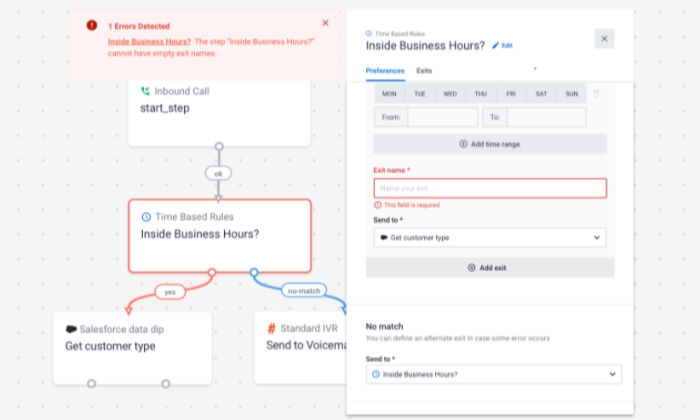
Sure, it’s possible to create an IVR that integrates your apps and databases with other options. But can you do it without writing a line of code?
Talkdesk CX lets admins and others build and customize IVRs quickly. There’s no need to get IT help just because departments shifted around. You’ll be able to give your customers a deeper range of options for self-service.
The more customers are able to help themselves, the more time agents are going to have to respond to other inquiries. There’s no sense tying your phone lines up with callers who want routine tasks or information.
It’s Payment Card Industry (PCI) compliant, so customers can pay bills and access account information directly from their phone.
Your agents will never have to ask for the three digit code on the back of the card again.
And with Talkdesk, this isn’t just on voice. You’ll have the same IVR function for text-based conversations, like chat and SMS. Chatbots aren’t a perfect solution for every customer inquiry, but they work wonders for the basic stuff.
Surveys are easy to include and automate as well. What could go better next time? What additional services would people like to be able to handle on their own? You can find out quickly and adjust your IVR in a couple of clicks.
I know companies that used to have to outsource all the work for their IVR. In all fairness, it used to be super complex. Talkdesk CX is changing the game.
I focused on the IVR for this review because that’s really where it stands apart, but don’t lose sight of the fact that Talkdesk CX is as good as it gets in virtually every area.
You get crisp reporting dashboards for management, an intuitive interface for agents, and integrations with leading CRMs and ecommerce platforms. Some of the other standout features include:
- AI agent assistance
- Intelligent call routing
- Predictive outbound dialer
- Business intelligence tools
- Speech analytics
- Deep coaching tools
Supervisors can listen to recordings of agent calls and leave time-stamped comments to offer concrete feedback about how to improve. Even if everyone is remote, supervisors can pinpoint issues and upskill agents.
Everything is a few clicks. All the information is right there–for customers and agents.
You’ll have to get in touch with Talkdesk for pricing, but the IVR studio is included with every plan they offer. With premium plans, you’ll get a low-code editor to be able to customize even more.
Take a closer look at this next-generation call center and request a quote from Talkdesk today.
What I Looked at to Find the Best Call Center Software
I make calls when I’m thinking about committing to a new product or service. Lots of people do.
The human connection is real, intimate, and—unfortunately—easy to mess up.
One dropped call. One mistaken name from an agent who’s spoken to 35 other people within the hour.
It doesn’t take much to lose a lead or earn a 1-star review carved in digital stone on the internet.
You’re looking for a system that establishes trust with customers because they know they can call and speak with the right person quickly.
It must also come with an interface that empowers agents by giving them insight into calls, client histories, and any other information they need to resolve issues in real-time.
Customers need prompt answers from helpful agents. End of story.
The best call center software comes with everything you need to meet these two fundamental call center objectives, and much more.
Here’s what you need to be thinking about as you make your choice.
Support For Every Channel Your Agents Use
The best call center software includes way more than voice communication. This is why you’ll see a lot of solutions marketed as contact center software instead. This reflects the common sense reality that people use way more than just phones to communicate.
Phones are still critical, but for many businesses, the ability to handle more channels is becoming increasingly important.
Some customers want to text. You want to be able to respond, or be able to text people reminders after they called in to schedule an appointment.
Or maybe you want to be able to seamlessly switch to a phone conversation with a customer who reached out via chat. They’re dying to speak to an actual human (you know the feeling). Making it happen earlier than they expect.
Here’s a list of the channels you can tie into a modern call center solution:
- Phone
- VoIP
- SMS and MMS
- Chat
- Social media
- Video and web conferencing
All of the solutions I looked at can handle most of these channels, though 8×8 Contact Center, Five9, and Talkdesk CX make it as easy as possible. These are known as omnichannel solutions, or unified communication as a service (UCaaS).
Regardless of how your customers make contact, your agents will be looking at every conversation within a single platform. They can see the whole relationship there, and give informed answers.
But not everyone needs everything. Some people don’t even need a blended call center that handles inbound/outbound calls. If inbound is all you need for customer service inquiries, just get that.
You will definitely have to pay over $100 per seat for UCaaS. If you really just want voice communications, Aircall is going to be less than half that, and it’ll be way easier to deploy.
There’s a big payoff for uniting all of your channels, but it’s going to take a lot of work and money to set up. The good news is that all my recommendations have tiered pricing and other options that let you add more channels over time.
You know what channels you use already, but what would you add if you could? Getting good call center software is an investment no matter how you swing it, so treat it as an opportunity to rethink how you connect with customers.
Ask them how they’d like to get in touch. Maybe they’d love it if they could text you. Maybe they already do and you just just don’t know.
Clear Visibility Into Agent Performance for Management
One of the key differences between call center software and a simple business phone system is quality assurance. Beyond the basic infrastructure to make calls, you are getting tools to organize and manage your workforce.
Supervisors know what their agents are doing in real time. They can jump in and listen on a call, whisper instructions the customer can’t hear, and help a new hire close their first sale.
They’re also better positioned to assist agents over time. With call recording, a customer service leader can supply tangible evidence in support of their guidance. Here’s exactly where you got off track–here’s another point where you were able to work back to the script successfully.
There are dashboards with clear metrics for supervisors, but also for sales managers and VPs. What’s the percentage of first call resolution? How many new leads are created per agent per month? Are you cutting average call time?
A lot of the most important metrics, such as cost per lead, are going to be a team effort between your call center software and CRM. Make sure the options you’re considering give you insight into the metrics that matter most.
Customers Connect to the Right Agent Automatically
Call center software comes with routing features that segment and direct incoming calls, potentially automating the processes which connect callers with the expert or agent they seek.
It could be making sure a priority support customer gets to speak with their dedicated service rep. Or it could be a lawyer ensuring that calls to her line go straight to a virtual receptionist while she runs to court to put out a last minute fire.
Here are a few of the popular call routing features you’re going to see:
- Automatic Call Distribution (ACD): Greets customers and allows them to select from a main menu or enter extension to route themselves.
- Automated attendant: Takes calls when all agents are busy, plays hold music, relays wait times, and reminds callers that their time is valuable.
- Intelligent call routing: Uses automation, AI, or interactive voice response to route customers to the most appropriate agent.
- Mobile device routing: Allows calls to be routed to mobile devices.
- Omnichannel routing: Allows calls to be routed across any channel.
- Skills-based call routing: Assigns calls go to the right agent based on relevant skills, like fluency in a particular language.
- Virtual hold: Gives customers the option to receive a call back when an agent is ready, instead of waiting on the phone.
- Warm transfer: Lets customers speak to a new agent before the call is transferred, and allows the previous agent to explain any ground that’s already been covered.
These features make a big difference. With warm transfer, for example, customers don’t have to repeat information over and over again. Agents love this, too, because they’re not getting yelled at for having to ask.
Another important feature is interactive voice response (IVR). This enables customers to use a phone to access information from a connected database. This could be someone calling to find out their checking balance, hear the status of their order, or pay a bill.
If you have customers routinely calling to access information, you can free up a lot of phone time simply by implementing IVR. It’s a truly self-service solution that helps people get what they want, without ever talking to an agent.
This all sounds amazing, but who is going to maintain this system? 8×8 and Talkdesk CX have drag-and-drop applications for creating phone trees, call flows, and IVRs. This means an administrator can switch up the phone tree when someone new joins the team instead of having to wait on IT support.
Integrations With The Tools Your Teams Depend On
Cloud-based phone systems boast, “No hardware required,” or they “deploy out of the box.”
It’s all really exciting, but will you really be “ready to start calling in minutes!”
Maybe–it depends what you are trying to do and what systems you have to tie into your new call center software.
Are you looking to connect to a popular CRM like Salesforce? It might be true one-click integration.
But have you customized your CRM? If that’s the case, the connection may need a little more attention to work properly.
There are a lot of similarities in what call center software does in theory–helps you keep better track of customers, route calls quicker, and so on–but in practice, none of this is going to work if the integrations are finicky.
If your helpdesk software doesn’t pass data back and forth with your call center software, agents are going to lose track of tickets. If your calendar doesn’t sync, it’s going to be impossible to set appointments. You get the picture.
You have to test drive these products in order to figure out the true quality of the integration.
There are native, pre-built, seamless, and direct integrations. What’s the difference between these? No one knows. Until you have seen it work in practice, take the term integration with a spoonful of salt.
Conclusion
Ten years ago, setting up a call center took months. Today, you can deploy one over the weekend. Let’s take a look at the entire list of my top picks:
- Nextiva – Best for taking your call center virtual
- Aircall – The lowest price on complete call center software
- Dialpad – The safe way to migrate your traditional call center to the cloud
- Five9 – Best for reaching more customers without adding reps
- 8×8 Contact Center – Best for large customer service call centers
- Talkdesk CX Cloud – Best for helping customers answer their own questions
Nextiva is a fantastic solution for running your call center in the cloud and making it totally futureproof.
Aircall is a really affordable option and it’s easy to get set up. It’s well within the small business price range, and you can try it for free for a week.
If you are just beginning your migration to the cloud, Dialpad is going to make your life a lot easier.
Follow the links to learn more about each product. My reviews are a good place to start, but you should get in touch for a demo or a trial. There’s no way to know how good call center software is until you’ve let agents experiment for a few days on the phone.
from Blog – Neil Patel https://ift.tt/2ViZ24Q
via IFTTT
No comments:
Post a Comment